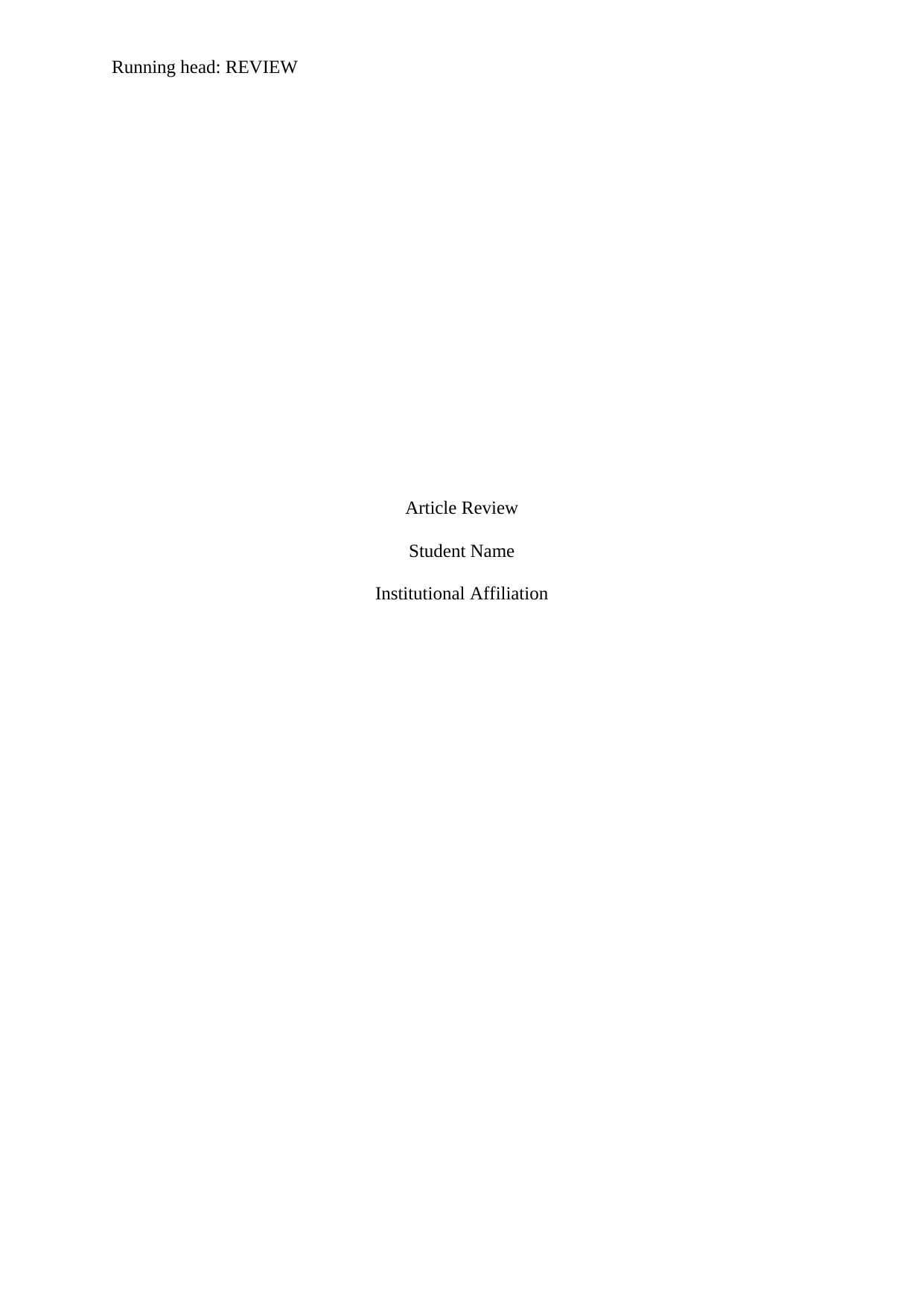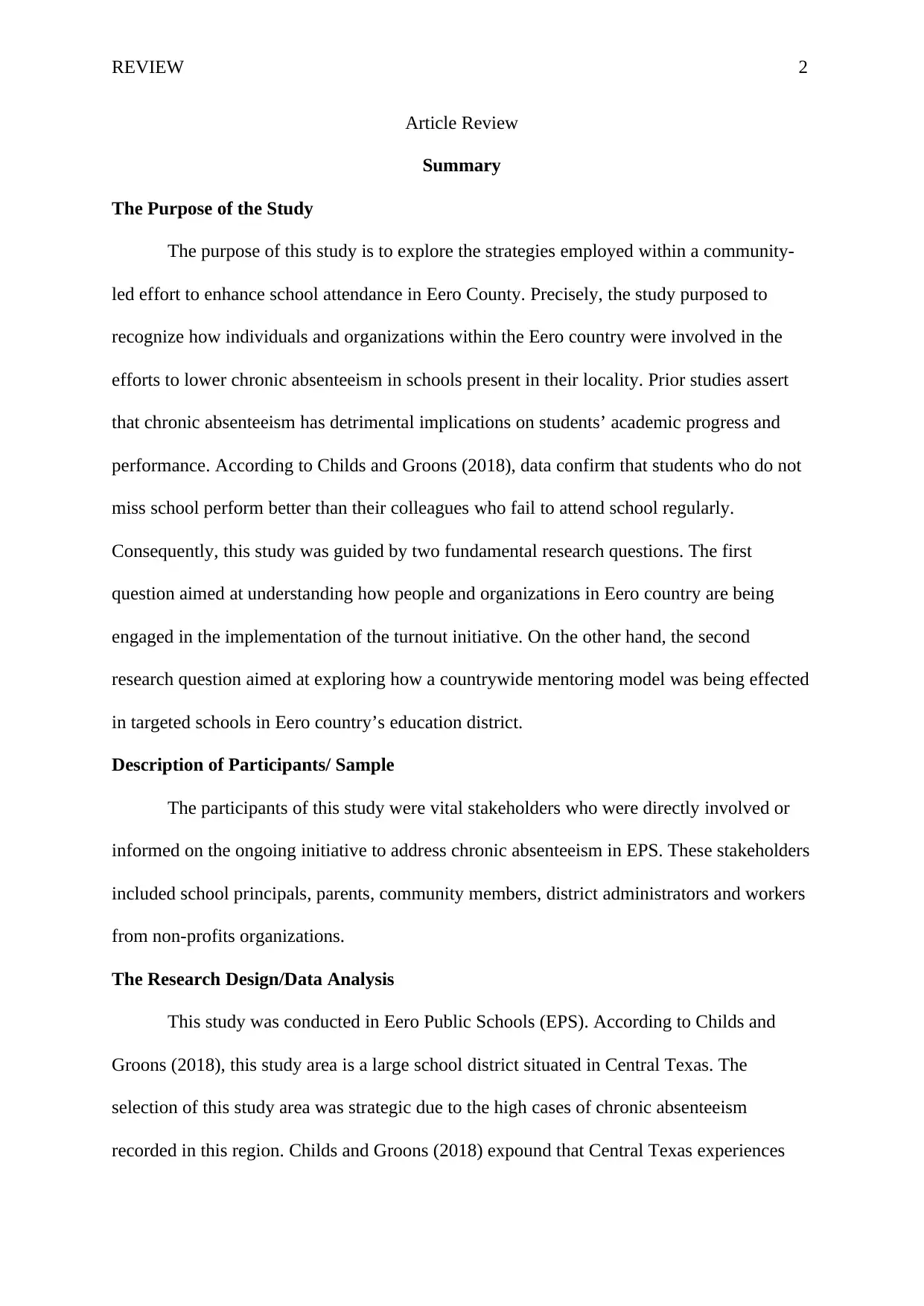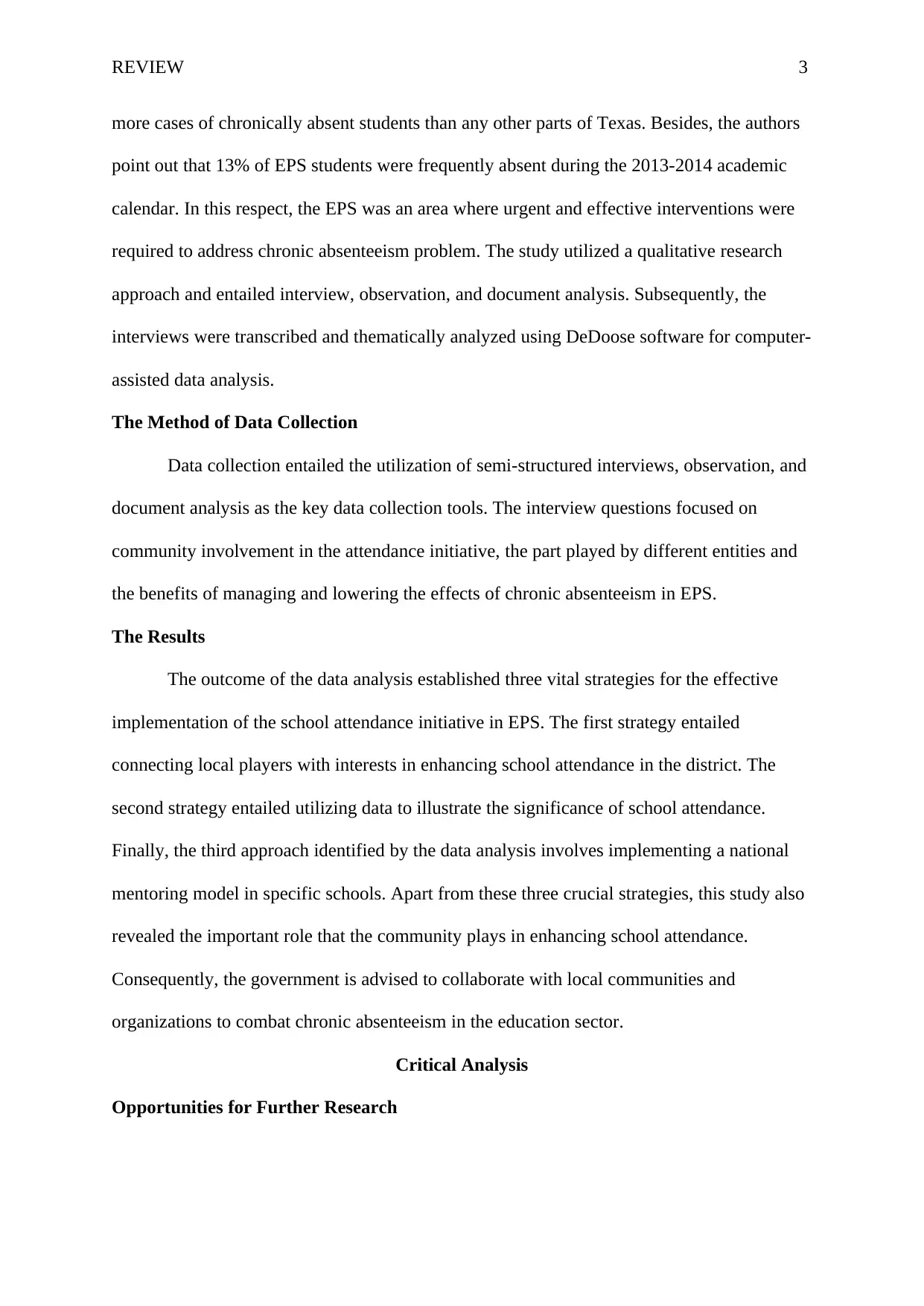Article Review: Strategies to Improve School Attendance in Eero County
VerifiedAdded on 2021/12/13
|6
|981
|75
Report
AI Summary
This article review summarizes a study investigating strategies for improving school attendance in Eero County, focusing on a community-led initiative to reduce chronic absenteeism. The study aimed to understand how individuals and organizations were involved in lowering absenteeism and how a mentoring model was implemented. Conducted in Eero Public Schools using a qualitative approach involving interviews, observations, and document analysis, the research identified three key strategies: connecting local stakeholders, utilizing data to highlight the importance of attendance, and implementing a national mentoring model. The study also emphasized the crucial role of community involvement. The review critiques the study's limited sample size and suggests further research to test the effectiveness of the identified strategies across more school districts. The findings have implications for school administrators and education policy, advocating for collaboration with parents and the replacement of punitive measures with more considerate approaches to address absenteeism.

Running head: REVIEW
Article Review
Student Name
Institutional Affiliation
Article Review
Student Name
Institutional Affiliation
Paraphrase This Document
Need a fresh take? Get an instant paraphrase of this document with our AI Paraphraser

REVIEW 2
Article Review
Summary
The Purpose of the Study
The purpose of this study is to explore the strategies employed within a community-
led effort to enhance school attendance in Eero County. Precisely, the study purposed to
recognize how individuals and organizations within the Eero country were involved in the
efforts to lower chronic absenteeism in schools present in their locality. Prior studies assert
that chronic absenteeism has detrimental implications on students’ academic progress and
performance. According to Childs and Groons (2018), data confirm that students who do not
miss school perform better than their colleagues who fail to attend school regularly.
Consequently, this study was guided by two fundamental research questions. The first
question aimed at understanding how people and organizations in Eero country are being
engaged in the implementation of the turnout initiative. On the other hand, the second
research question aimed at exploring how a countrywide mentoring model was being effected
in targeted schools in Eero country’s education district.
Description of Participants/ Sample
The participants of this study were vital stakeholders who were directly involved or
informed on the ongoing initiative to address chronic absenteeism in EPS. These stakeholders
included school principals, parents, community members, district administrators and workers
from non-profits organizations.
The Research Design/Data Analysis
This study was conducted in Eero Public Schools (EPS). According to Childs and
Groons (2018), this study area is a large school district situated in Central Texas. The
selection of this study area was strategic due to the high cases of chronic absenteeism
recorded in this region. Childs and Groons (2018) expound that Central Texas experiences
Article Review
Summary
The Purpose of the Study
The purpose of this study is to explore the strategies employed within a community-
led effort to enhance school attendance in Eero County. Precisely, the study purposed to
recognize how individuals and organizations within the Eero country were involved in the
efforts to lower chronic absenteeism in schools present in their locality. Prior studies assert
that chronic absenteeism has detrimental implications on students’ academic progress and
performance. According to Childs and Groons (2018), data confirm that students who do not
miss school perform better than their colleagues who fail to attend school regularly.
Consequently, this study was guided by two fundamental research questions. The first
question aimed at understanding how people and organizations in Eero country are being
engaged in the implementation of the turnout initiative. On the other hand, the second
research question aimed at exploring how a countrywide mentoring model was being effected
in targeted schools in Eero country’s education district.
Description of Participants/ Sample
The participants of this study were vital stakeholders who were directly involved or
informed on the ongoing initiative to address chronic absenteeism in EPS. These stakeholders
included school principals, parents, community members, district administrators and workers
from non-profits organizations.
The Research Design/Data Analysis
This study was conducted in Eero Public Schools (EPS). According to Childs and
Groons (2018), this study area is a large school district situated in Central Texas. The
selection of this study area was strategic due to the high cases of chronic absenteeism
recorded in this region. Childs and Groons (2018) expound that Central Texas experiences

REVIEW 3
more cases of chronically absent students than any other parts of Texas. Besides, the authors
point out that 13% of EPS students were frequently absent during the 2013-2014 academic
calendar. In this respect, the EPS was an area where urgent and effective interventions were
required to address chronic absenteeism problem. The study utilized a qualitative research
approach and entailed interview, observation, and document analysis. Subsequently, the
interviews were transcribed and thematically analyzed using DeDoose software for computer-
assisted data analysis.
The Method of Data Collection
Data collection entailed the utilization of semi-structured interviews, observation, and
document analysis as the key data collection tools. The interview questions focused on
community involvement in the attendance initiative, the part played by different entities and
the benefits of managing and lowering the effects of chronic absenteeism in EPS.
The Results
The outcome of the data analysis established three vital strategies for the effective
implementation of the school attendance initiative in EPS. The first strategy entailed
connecting local players with interests in enhancing school attendance in the district. The
second strategy entailed utilizing data to illustrate the significance of school attendance.
Finally, the third approach identified by the data analysis involves implementing a national
mentoring model in specific schools. Apart from these three crucial strategies, this study also
revealed the important role that the community plays in enhancing school attendance.
Consequently, the government is advised to collaborate with local communities and
organizations to combat chronic absenteeism in the education sector.
Critical Analysis
Opportunities for Further Research
more cases of chronically absent students than any other parts of Texas. Besides, the authors
point out that 13% of EPS students were frequently absent during the 2013-2014 academic
calendar. In this respect, the EPS was an area where urgent and effective interventions were
required to address chronic absenteeism problem. The study utilized a qualitative research
approach and entailed interview, observation, and document analysis. Subsequently, the
interviews were transcribed and thematically analyzed using DeDoose software for computer-
assisted data analysis.
The Method of Data Collection
Data collection entailed the utilization of semi-structured interviews, observation, and
document analysis as the key data collection tools. The interview questions focused on
community involvement in the attendance initiative, the part played by different entities and
the benefits of managing and lowering the effects of chronic absenteeism in EPS.
The Results
The outcome of the data analysis established three vital strategies for the effective
implementation of the school attendance initiative in EPS. The first strategy entailed
connecting local players with interests in enhancing school attendance in the district. The
second strategy entailed utilizing data to illustrate the significance of school attendance.
Finally, the third approach identified by the data analysis involves implementing a national
mentoring model in specific schools. Apart from these three crucial strategies, this study also
revealed the important role that the community plays in enhancing school attendance.
Consequently, the government is advised to collaborate with local communities and
organizations to combat chronic absenteeism in the education sector.
Critical Analysis
Opportunities for Further Research
⊘ This is a preview!⊘
Do you want full access?
Subscribe today to unlock all pages.

Trusted by 1+ million students worldwide

REVIEW 4
Future research should conduct comprehensive studies involving more than half of all
education districts in the United States. Importantly, future studies should focus on testing the
implications of the strategies proposed by this study. It is vital to point out that the present
study failed to assess the effectiveness of the identified strategies for decreasing chronic
absenteeism. As a result, future studies need to focus on this inadequacy.
Threats to Validity
Despite its vital findings, this study entails several threats to validity. Firstly, the study
used a limited sample of only one school district. This use of a limited study sample lowers
the validity of the study findings making them inapplicable to the wider United States
education sector. In essence, the study should have sampled more than one district to at least
produce results that adequately represents the nature of the entire United States education
sector.
Other Original Insight or Criticism
This study focuses on a highly sensitive issue in the United States education sector.
Different players in the education sector, including scholars, have spent many years exploring
effective ways of reducing chronic absenteeism in schools. However, it appears that the
solution to this vice lies in the collaboration between the community, local organizations, and
the government as identified in this study. As a result, this study serves as an eye-opener to
stakeholders in the education sector who have unsuccessfully tried to combat absenteeism in
the past.
Implications of the Findings.
Despite these insufficiencies, the findings of this study have vital implications for
practice and education policy. For practice, the findings of this study advice principals and
school administrators to revise how they handle absenteeism in their institutions. Precisely,
this study suggests that principals and administrators need to collaborate with parents and
Future research should conduct comprehensive studies involving more than half of all
education districts in the United States. Importantly, future studies should focus on testing the
implications of the strategies proposed by this study. It is vital to point out that the present
study failed to assess the effectiveness of the identified strategies for decreasing chronic
absenteeism. As a result, future studies need to focus on this inadequacy.
Threats to Validity
Despite its vital findings, this study entails several threats to validity. Firstly, the study
used a limited sample of only one school district. This use of a limited study sample lowers
the validity of the study findings making them inapplicable to the wider United States
education sector. In essence, the study should have sampled more than one district to at least
produce results that adequately represents the nature of the entire United States education
sector.
Other Original Insight or Criticism
This study focuses on a highly sensitive issue in the United States education sector.
Different players in the education sector, including scholars, have spent many years exploring
effective ways of reducing chronic absenteeism in schools. However, it appears that the
solution to this vice lies in the collaboration between the community, local organizations, and
the government as identified in this study. As a result, this study serves as an eye-opener to
stakeholders in the education sector who have unsuccessfully tried to combat absenteeism in
the past.
Implications of the Findings.
Despite these insufficiencies, the findings of this study have vital implications for
practice and education policy. For practice, the findings of this study advice principals and
school administrators to revise how they handle absenteeism in their institutions. Precisely,
this study suggests that principals and administrators need to collaborate with parents and
Paraphrase This Document
Need a fresh take? Get an instant paraphrase of this document with our AI Paraphraser

REVIEW 5
eradicate punitive measures when handling absenteeism. On policy issues, this study suggests
the abolishment of punitive measures currently used in addressing chronic absenteeism and
replacing them with more considerate measures.
eradicate punitive measures when handling absenteeism. On policy issues, this study suggests
the abolishment of punitive measures currently used in addressing chronic absenteeism and
replacing them with more considerate measures.

REVIEW 6
References
Childs, J., & Grooms, A. A. (2018). Improving school attendance through collaboration: A
catalyst for community involvement and change. Journal of Education for Students
Placed at Risk, 23(1-2), 122-138.
References
Childs, J., & Grooms, A. A. (2018). Improving school attendance through collaboration: A
catalyst for community involvement and change. Journal of Education for Students
Placed at Risk, 23(1-2), 122-138.
⊘ This is a preview!⊘
Do you want full access?
Subscribe today to unlock all pages.

Trusted by 1+ million students worldwide
1 out of 6
Related Documents
Your All-in-One AI-Powered Toolkit for Academic Success.
+13062052269
info@desklib.com
Available 24*7 on WhatsApp / Email
![[object Object]](/_next/static/media/star-bottom.7253800d.svg)
Unlock your academic potential
Copyright © 2020–2025 A2Z Services. All Rights Reserved. Developed and managed by ZUCOL.





